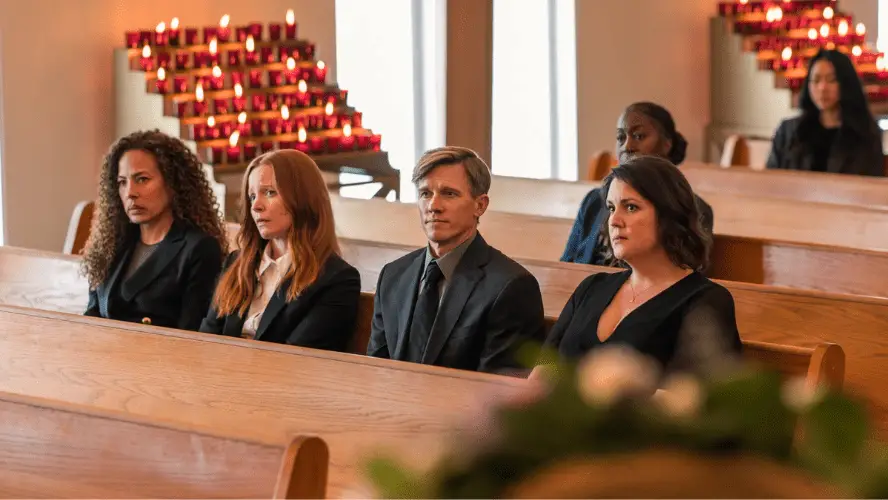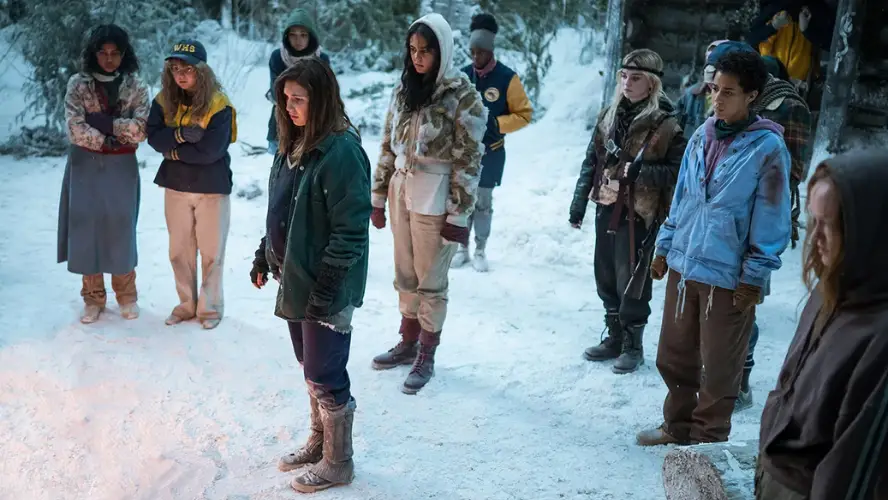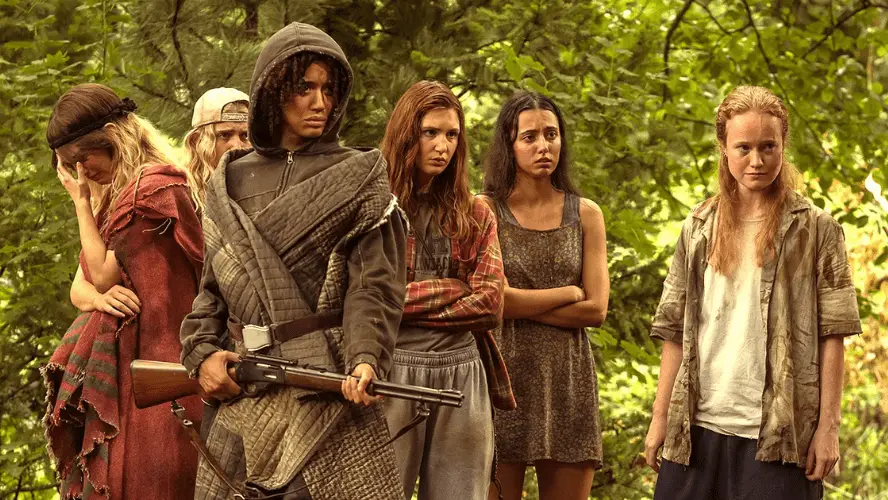This post contains specific spoilers for up to season 2 and mild spoilers for up to season 3 of Yellowjackets.
I have been a fan of Yellowjackets since the first season aired and was lucky enough to catch wind of it early enough to watch the show weekly nearly from the beginning. It does so much thematically, tonally, and in terms of genre, juggling aspects of horror, drama, comedy, and even a bit of camp as it explores the lives of a girls’ soccer team that survives a plane crash during their stay in the Canadian wilderness and 25 years later.
Yellowjackets is also, to my utter delight, uninterested in heroes and villains. It explores the characters’ personalities and quirks and how they’re affected by the trauma they experience, which reveals the best and worst parts of them. It’s also an anti-mystery box, letting us know up front that eventually the worst parts win.
The narrative also suggests a supernatural element that may or may not be an entity that’s pulling the strings and demanding blood sacrifices or a coping mechanism that the girls use to deal with what’s happening.
The four main survivors in season 1, Shauna, Misty, Taissa, and Natalie show us a gamut of ways to deal with past wrongdoings in the wilderness, ranging from repression and self-punishment to overwhelming guilt and substance abuse to complete dissociation to actually cherishing and possibly missing their time in the wilderness.
The show is very smart about presenting these characters to us from the pilot, revealing what’s likeable, relatable, and even what’s despicable about each girl. Yellowjackets isn’t a show that’s particularly interested in likability or on judging the characters based on real world standards. Rather, it’s interested in exploring who the characters are, what pushes their buttons, and what leads them to reach the extremes we see from the pilot episode.
Throughout the story, all of the characters do bad, even monstrous things. Some of them struggle with the morality of their struggles individually, but the narrative itself doesn’t judge or condemn them. It does an excellent job of showing us where they’re coming from and how they got to those places. In the adult timeline, the narrative is interested in how each person deals with (or doesn’t deal with) what’s happened to them and what they’ve done.

Not Anti-Heroes or Villains, Just Girlfailures
Television has always had shows that explore complicated, morally gray characters, examining their psychology and behavior, without necessarily looking to redeem or villainize them, just humanize them. On the drama side, you have your Mad Mens, your Breaking Bads, your Successions, and then on the other end of the spectrum, your Barrys, your Bojack Horsemans, and your Hacks. Most of these shows have their genres more or less clearly defined.
Yellowjackets walks many lines; it’s comedic and fun to watch a lot of the time, making it more palatable for wider audiences than the serious dramas. Then, the show delves into the drama and the violence in an unflinching way that can be hard to watch. Ultimately, I would call the show a tragedy, at its core.
No Return, No Reason
Social media discussions seem to lean a lot into morality, at least from my limited perspective. There’s a tendency for audiences to want the media they consume, or at the very least the characters they favor, to align with their morals. This gets complicated quickly with any show worth its salt, but even more with a show like Yellowjackets.
I find this sort of discourse unproductive when it comes to these characters, and generally feel like it flattens them and their complexities, one way or the other.
Yellowjackets is not a didactic show. It’s not trying to show us an uplifting survival story or aiming for the women in it to set an example for the audience. It is, however, valuable in its portrayal of trauma, grief, guilt, and shame, and how that manifests in the girls’ and later the women’s behavior, their view of themselves, and their eventual development as adults.
They all start the show as teenage girls with normal teenage girls’ flaws, and their lives range from middle class comfort to neglect, but still within the bounds of reality. Some have existing traumas or past wrongdoings, and all of them have fatal flaws.
Shauna and Jackie have a complicated relationship where neither is communicating well with the other, despite their deep love for one another. Jackie is unhappy in her relationship and her life but projects a veneer of perfection, protecting herself with her outward-facing image, leading her to control her best friend, keeping her on a leash on her, since she is part of that perfection image.
Shauna loves Jackie but is resentful of her and jealous of her life and apparent effortlessness. From the start, she is unable to cope with negative emotions in a healthy way, and bottles them up until they come out out in anger and impulsive bad decisions, such as sleeping with Jackie’s boyfriend, Jeff.
I am also partial to the interpretation that Shauna and Jackie are in love with each other. However, they’re both so deep in compulsory heterosexuality that they have no real awareness that their intense feelings (negative and positive) and behavior towards the other is caused by that.
Natalie witnessed her father’s accidental death, which she blames herself for, and deals with it through drugs and alcohol. Taissa is intense and harsh on everyone, including herself. Misty is bullied (and most definitely neurodivergent) and feels deeply unloved, and she deals with it by overcompensating with overbearing care for people, which, combined with constant misreadings of social cues, makes people feel smothered. Lottie is a rich girl with schizophrenia and a neglectful father.
The plane crash and the subsequent 19 months in the Canadian wilderness exacerbates the girls’ traits, especially their flaws. The tragedy of the show is that each of them loses the opportunity to grow out of their flaws, deal with their mistakes, or develop their personalities in a normal way.
Misty feels herself valued and needed for the first time in her life, so she doubles and triples down on her overbearing tendencies. Taissa is so incapable of dealing with what’s needed to survive and with what she really wants that she creates an entire separate personality to cope. Nat’s tendency to freeze as an emotional response lands her again and again in moral conundrums that cause literal deaths. Lottie, off her meds, begins having delusions, and through a series of coincidences or supernatural interventions (or both), she accidentally starts a proto-religion that will lead to the girls’ doom.
Meanwhile, Shauna and Jackie’s inevitable blowout happens in a place where everything is life or death, and it turns out to be fatal for Jackie in a terribly tragic way. This obliterates any chance Shauna had of properly dealing with her complicated feelings towards Jackie.
Two Realities
The show has reportedly had influence from Lord of the Flies, My So-Called Life, and Twin Peaks. From the beginning, we are told that things in the wilderness will take a turn for the worst. The pilot starts with the death of a girl, which, throughout the episode, is revealed to be a cannibalistic ritual. In a way, I see the show as a writing challenge of how you can take these girls from A to Z believably.
The writers have very smartly created the conditions for this to happen, spearheaded by the four main characters. The girls’ fatal flaws are well-established, drawing a picture of what could happen if their worst instincts were fed. The wilderness does feed them, and the show puts them through unspeakable trauma.
For example, the wilderness has been hard on Shauna; she’s lost her best friend and her baby and taken on a harrowing role as the butcher. Her compounded losses, combined with her own inability to cope with negative emotions and take accountability in healthy ways, results in Shauna resorting to rage to try to cope with the crushing weight of shame, guilt, and grief.

The supernatural aspect is also a key factor in setting the stage for things to turn into what we see in the pilot. Lottie provides the conduit for this explosive combination of fatal flaws, trauma, and desperation to become a cannibalistic cult. Her connection to the wilderness feeds the girls through part of the first brutal winter and gives them a sliver of hope to hold on to.
Personally, I am a subscriber to the supernatural as a representation of the girls’ corruption spiral. I think it makes the show more interesting and rich. However, I believe it’s important that the existence of the capital W Wilderness remains ambiguous, for both the audience and for the characters. We must each decide for ourselves, and should the girls. I tend to think it’s both the wilderness and not, which I believe feeds into the main theme of the show.
Shauna: You know there’s no ‘it,’ right? It was just us!
Lottie: Is there a difference?
Season 2, episode 9
Mari: I think maybe there are two versions of reality. Most of the time, the other one, the bad one, is just hiding or waiting. But it’s all real.
Season 3, episode 3
Teenage Girls Bad?
There are no monsters among humans. Rather, humans are capable of monstrous things, and we tend to want to separate the people who commit unspeakable acts from our own humanity by calling them monsters. Deconstructing this, I believe, is one of the central themes of the show.
The girls don’t suddenly become horrible. They all slowly lose themselves as the months go on, as the hunger sets in, as they get desperate, as trauma is dumped on them.
We see each of these characters as normal teenagers, we relate to some more than others, and then, we see them all do monstrous, unspeakable things. There’s a discomfort in that, especially when looking at a character you relate to, when you understand where they’re coming from.
Fans online like to joke about how Shauna was always a monster, but while her sleeping with Jeff was wrong, it’s a pretty teenager mistake to make. It’s not a horrendous act like we’ve started to see her commit in season three. Before enduring all that loss and trauma, she was a pretty normal, well-rounded girl. She was jealous and resentful, but also empathetic and caring to her teammates. She was willing to run into a burning plane to save Van and was kind enough to bond with Javi and offer him an outlet for his feelings with a few pages of her journal.
Shauna’s heinous actions in season 3 are not excusable, but they can always be traced back to what’s happened to her and how her personality reacts to all of it. She’s afraid of introspection because she has so much guilt and shame about what happened to Jackie and her baby. Her pain has become so unbearable that she’s turning it outward, into rage. It’s unhealthy and twisted, and she’s letting herself become the worst version of herself.
She unravels before our eyes, slowly, throughout seasons 1 and 2, until almost nothing of that original girl seems to be left. Embracing her character as she is, without judging her, becomes hard. Shauna is the best example of the deconstruction of the ‘monster’ idea on Yellowjackets. She’s presenting some of the ugliest manifestations of human reaction to trauma. If you ask me, her portrayal is bold, both on the part of the writers and of Melanie Lynskey and Sophie Nélisse, who play her.
I personally love the show’s unsanitized portrayal of rage. I appreciate the way the adults are portrayed, showing that they’re in a state of arrested development, stuck in the past no matter how hard they try to escape it, get over it, or repress it. Except for Misty, of course, who clings to it because the wilderness is the only time she’s truly felt part of the team and embraced by a community.
I don’t believe Yellowjackets is trying to say all teenage girls are bad, nor do I think it portrays the girls as fundamentally bad people, or says that they would have inevitably become this no matter what. The show lays very specific foundations for the worst to happen, so of course it does.
The characters are all shaped by their experiences and their poor decisions. The tragedy is in how much they’ve lost themselves. We have enough information about them to imagine the people each of them could have become if they’d just gotten a fighting chance to work their issues out in the real world. The wilderness took that chance from them, and that’s devastating.
Embrace The Mess
Yellowjackets isn’t a perfect show (there’s no such thing). The cutaways between the adult and teenage timelines in past seasons has been a sticking point for much of the audience, including myself. The adult timeline has been the writers’ biggest challenge, in my opinion. I haven’t always found the storylines compelling. Plus, since they have been rightfully keeping close to their chest the extent of what happened in the wilderness, the adults sometimes seem to be unnecessarily obscure in their conversations with each other for the audience’s benefit. Season 3 has been a huge step-up in that area, though!
Ultimately, no show is for everyone. Yellowjackets has an excellent cast of characters and actors of two different age groups, whose appeal can be very wide. However, despite its teenage character cast, it is very much a show for adults. It’s pretty violent (never without thematic significance, I would say) and morbid while keeping a high degree of entertainment value. It’s also rife with metaphor and symbolism, and there are mysteries the show will never answer, on purpose, which can be frustrating for a large portion of modern TV audiences.
The tonal shifts within the narrative can also be disconcerting and make the show hard to pinpoint, which I’ve also noticed can be another point of contention with audience expectation. Ultimately, Yellowjackets isn’t a feel-good, inspirational show about survival. It’s a show about women who fall prey to their worst instincts, time and time again. They are victims and victimizers, and none of them, even the ones who are portrayed more sympathetically, are free from this.

As such, I don’t think Yellowjackets is a show you’d get much out of from moralizing the characters, and even less ‘woobifying’ or villainizing them. Not to mention if you are twisting yourself into knots trying to argue how your favorite cannibal is the most morally correct. You wouldn’t get much more out of that than getting angry at the TV week after week.
Watching with a shipping lens could be even less enjoyable if you need your ships to be canon against all odds. Legitimately any time any two characters interact, it feels profound and charged — because it is. The love, hate, and deep trauma bond these characters share truly transcends romantic love or sexual attraction. That means it’s easy to ship at your heart’s content if you want to have fun with it. However, Yellowjakcets is not really a show focused on ships that’s purposefully playing at Team This Girl vs. Team That Girl. The show has never focused on that kind of dynamic.
This is the “women doomed by the narrative” show, through and through. It’s doing so many interesting, fresh things with a cast primarily of teenage girls and middle-aged women. It has some of the most layered, complex relationships between women on TV right now. It’s also doing the most with its teenage relationships, exploring their nuances, shortcomings, and bright spots in a way most teen shows don’t.
I recently read a post (that of course I couldn’t find again) that rightly stated Yellowjackets would be an excellent show without the plane crash, just working with the characters established in the pilot navigating high school and their relationships to each other. I wholeheartedly agree with that statement, and I believe it’s a testament that, at its core, the characters are what makes Yellowjackets shine.
If you’re willing to, you can let yourself enjoy an hour a week of supporting women’s wrongs — always knowing and embracing that they’re wrongs — and then have food for thought and space to dissect each character’s thought process, motivation, headspace and take a look at how they’ve gotten here (with us on Discord if you so wish!). I just think it’s a fantastic show, and it’s the most fun I’ve had with television in years, and I just wanted to share with the class.
Images courtesy of Showtime.
Have strong thoughts about this piece you need to share? Or maybe there’s something else on your mind you’re wanting to talk about with fellow Fandomentals? Head on over to our Community server to join in the conversation!

